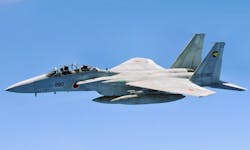Boeing to upgrade Japan's F-15 jet fighters to enable the aircraft to fight effectively alongside the F-35
WRIGHT-PATTERSON AFB, Ohio – Jet fighter designers at the Boeing Co. will help Japan upgrade its F-15 combat aircraft with new enabling technologies to enable Japanese F-15s to fight effectively alongside the nation's growing fleet of F-35 joint strike fighters.
Officials of the U.S. Air Force Life Cycle Management Center at Wright-Patterson Air Force Base, Ohio, announced a $471.3 million contract to the Boeing Defense, Space & Security segment in St. Louis for the Japan Super Interceptor (JSI) program.
The contract calls for Boeing to develop an integrated suite of aircraft systems to support modification of the Japan Air Self Defense Force F-15MJ aircraft four weapon system trainers.
The contract is part of a potential $4.5 billion program approved by the U.S. State Department in 2019 to upgrade 98 Boeing F-15J jet fighters to Japan Super Interceptor aircraft.
These updated aircraft are expected to fly alongside Japan’s fleet of Lockheed Martin F-35 fighter-bombers and take advantage of the strongest capabilities of each aircraft. The F-35 is stealthy with advanced airborne networking, while the F-15 is fast, long range, and carries a large weapons payload.
The JSI upgrade includes new systems like the Raytheon's AN/APG-82(V)1 active electronically scanned array (AESA) radar and the BAE Systems AN/ALQ-239 digital electronic warfare (EW) system. The JSI also could carry new missiles.
The Japan Super Interceptor program is expected to be similar to the U.S. F-15EX aircraft, which will augment the new F-35 with plenty of fire power on an affordable budget.
In 2020 the U.S. Air Force announced a potential $22.9 billion contract to Boeing to design and build the F-15EX jet fighter.
The F-15EX is based on the F-15 Advanced Eagle that Boeing is building for the air forces of Qatar and Saudi Arabia, which has a fly-by-wire flight control system, digital electronic warfare (EW) suite, an infrared search and track (IRST) system, and the Raytheon APG-63(v)3 AESA radar.
The F-15EX carries more weapons than similar fighter aircraft, and will be able to launch hypersonic weapons that are as large as 22 feet long weight as much as 7,000 pounds. The F-15EX also is following the U.S. Department of Defense (DOD) DevSecOps initiative to develop secure, flexible, and agile software and an open-systems avionics architecture.
The F-15EX will be a large, powerful, non-stealthy, twin-engine jet fighter able to carry a large air-superiority weapons payload. The plane will be able to carry as many as 22 AIM-9X Sidewinder and AMRAAM medium range air-to-air missiles.
It also will have a substantially more powerful mission computer than all existing versions of the F-15, new cockpit displays, a digital backbone, infrared search and track (IRST) system, the Raytheon APG-63(v)3 active electronically scanned array (AESA) radar, and the Eagle Passive Active Warning Survivability System (EPAWSS) -- an electronic warfare and threat identification system.
The F-15EX also will have terrain-following radar to enable the pilot to fly at a very low altitude following cues displayed on a heads up display. The targeting pod contains a laser designator and a tracking system with a 10-mile range. The plane also will have as many as 11 underwing weapons stations and digital Joint Helmet-Mounted Cueing Systems. The original F-15 jet fighter began development in 1967, and entered service with the U.S. Air Force in 1976.
On this contract Boeing will do the work in St. Louis and should be finished by December 2028. For more information contact Boeing Defense, Space & Security online at www.boeing.com, or the Air Force Life Cycle Management Center at www.aflcmc.af.mil.
About the Author
John Keller
Editor-in-Chief
John Keller is the Editor-in-Chief, Military & Aerospace Electronics Magazine--provides extensive coverage and analysis of enabling electronics and optoelectronic technologies in military, space and commercial aviation applications. John has been a member of the Military & Aerospace Electronics staff since 1989 and chief editor since 1995.
